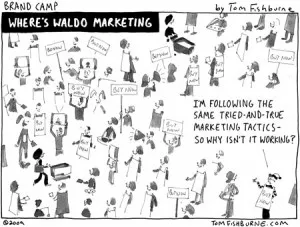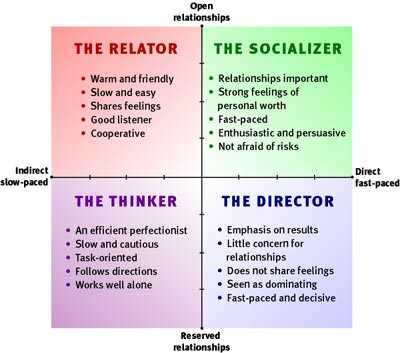Our marketing team recently attended a business writing seminar. Hands down, we all agreed that the most valuable lesson learned was about different behavioral styles. These styles greatly influence how you communicate and how you receive communication (i.e. product marketing and sales pitches!)

People don't all respond to marketing the same way. Some only scan the headline and bullet points while others scrutinize the fine print. Understanding how different personality styles like to communicate will help you to reach more of your target audience.
We've all heard the Golden Rule: do unto others as you would have them do unto you. It is a great principle, but the heart behind it tends to get lost in practice. We tend to look at a situation and think to ourselves, "Hmm, how would
I want to be treated here?" The problem comes when the way
I want to be treated is different from the way
you want to be treated.
An easy example of this comes in marriage. When I have a hard day, I want to cuddle with my husband on the couch and vent a little bit, while he listens attentively and gives me some encouraging words. On the other hand, when my husband has a hard day, he wants to escape for awhile with a video game. How would it work out if he told me he had a hard day and I tried to treat him the way I want to be treated? It would blow up in my face!
The heart behind the Golden Rule is really to treat others the way
they want to be treated. That means I respectfully let my husband have some unwind time on the Wii and make sure the kids don't bother him. Usually, it doesn’t take long for him to decompress and the rest of the evening is quite pleasant.
How does this relate to business? In every way! Companies are made up of people. Our customers are people. How we interact with people has a huge impact on the success of your business and your career. A national survey showed that
68% of customers leave a supplier because of the attitude of one employee!
At some point, I'm sure you've heard about the different personality types or maybe personality temperaments. Many companies have their employees take a personality test to see what their potential strengths and weaknesses are. What we learned about in the seminar is a bit of a twist off of those.
The Nightingale-Conant system creates a graph with four quadrants. Where you fall on the graph is based on how open or reserved (X-axis) you are and how direct or indirect (Y-axis) you are.
Open vs. Reserved
How open are you with your communication? Is it easy for you to talk about your feelings, thoughts, and opinions even in a new group? Open people are usually pretty easy to spot. They tend to be quick to share a lot of personal information and to be very expressive. They are also good at maintaining eye contact. They are people-orientated, so good relationships are very important to them.
On the other hand, does it take people awhile to get to know you? Are getting things accomplished more important than getting to know your coworkers or clients? Reserved people are more comfortable with keeping a certain distance in their relationships. They tend to want a bit more personal space and are not quick to get into deep discussions.
Direct vs. Indirect
Are you very direct with your communication? Are you fast-paced and assertive? Direct people usually are not afraid to speak up in meetings, even if their point is in contrast to the group's opinion. In fact, they are likely to be argumentative and will stubbornly defend their position. They might be described as competitive or controlling by their indirect colleagues. Direct people are not afraid to take risks, but being unwilling to accept others' ideas can lead to problems.
Indirect people work at a slower, more deliberate pace. They are not risk takers, but they are very reliable and pride themselves on accuracy and thoroughness. It's not hard to find the indirect people at a party. They are the ones standing against the wall, observing everyone else, or they are engaged in a quiet conversation with one or two friends.

Now that you have marked where you fall on each of the axes, look at the graph above and see which quadrant touches both of your marks. Is your communication style that of a Relater, Socializer, Director, or Thinker?
The Relater
Relaters want everyone to get along. They are friendly and usually are great working in a team. Their desks are typically decorated with personal items, like photos, plants, and knick knacks. It's more important to a Relater to have a happy team than to get tasks completed on time.
Marketing to the Relater
They aren't trailblazers, but they want to be a part of the group. They want to hear how everyone else is doing it, so include testimonials and case studies. They tend to read the last paragraph first, especially the P.S.
The Socializer
Socializers want to get recognized. They thrive on positive acknowledgement. They want lots of people around them to hear about the cool thing they did, bought, or experienced last weekend. They are typically fun, energetic, and easily distracted on tedious tasks.
Marketing to the Socializer
They are the risk-takers and early adopters. They want the hot new thing and to be one of the first to get it. They like to read headlines, captions on pictures, and bullet points.
The Director
Directors want to get it done. They are very task-orientated and fast-paced. Directors are concerned with the bottom-line, not the details. They are often seen as quite competitive and impersonal. They can be counted on to get things accomplished, but perhaps at the expense of others' feelings.
Marketing to the Director
Get right to the point. They read the headline and the first paragraph. Focus on how your product will help them to reach their goals.
The Thinker
Thinkers want to get it right. They love all the details: who, what, where, how, why, etc. They are neat, organized, and analytical. They move slowly and cautiously to avoid all risk. Thinkers can get stuck in their analysis if there isn't a clear right and wrong choice.
Marketing to the Thinker
Give them the details, the facts, and the proof. They look for the fine print. They make decisions based on the data, not on emotions.
I hope that you find all of this as informative and useful as we did. It was fun to analyze each other over lunch and try to figure out what types we are. Once we got our business thinking caps back on, we started thinking about our current marketing and what we need to modify so that we can speak to each of these types effectively.

